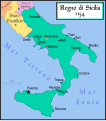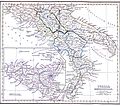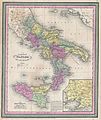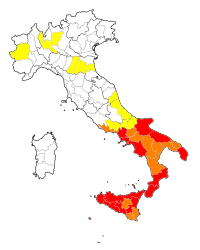Southern Italy
As southern Italy (or southern Italy , Italian Italia meridional or Sud Italia , also Bassa Italia or Mezzogiorno , Sicilian Italia du Sud , neapolitanisch 'o Mezzogiorno or Sud Italia ), the southern part of Italy , usually starting with the current region Abruzzo designated.
Word origin "Mezzogiorno"
The term, composed of mezzo [ mɛddzo ] (middle) and giorno [ dʒorno ] (day), is the Italian word for “noon”. Mezzogiorno means the south in general (according to the position of the sun); derived from this, the word in its most common usage denotes the south of Italy. Accordingly, the term Le Midi (noon) is used for the south of France.
meaning
Italy decided in the 1950s to support the underdeveloped south with transfer payments from the “rich north” and central Italy. The example of Mezzogiorno is often referred to in the course of German reunification and the following problems of “ rebuilding the East ”. In eastern Germany and in the Mezzogiorno, for example, productivity levels have been around 60 percent relative to the rest of the country (northern Italy and western Germany) because of the payments.
In 2013, the gross domestic product of the south (€ 17,416 per capita) was 42% less than that of the north (€ 31,094 per capita). Between 2009 and 2012 GDP fell by 3.8% in the south, while in Italy the decrease was only 0.4%.
Geographical demarcation
Southern Italy consists of today's Italian regions that belonged to the Kingdom of the Two Sicilies before the unification of Italy in 1861 ; these are the regions of Abruzzo , Molise , Campania , Basilicata , Apulia , Calabria and Sicily . Although the island of Sardinia, which was previously ruled by the House of Savoy , is culturally and historically separated from southern Italy, it also belongs to the Mezzogiorno due to similar economic conditions .
For statistical purposes, Italy is divided into five macro-regions according to the NUTS classification of the European Union . The southern Italian regions on the mainland form the macro region "South" ( Sud ), Sicily and Sardinia the macro region of the "islands" ( Isole , also Italia insulare ).
In terms of economic geography, the Abruzzo region is counted as part of Central Italy , as the economic output of the region corresponds more closely to that of the Central Italian regions. It has not been an Objective 1 region of the European Union since 2007 . The Abruzzo region can be assigned to Central Italy based on purely geographical criteria. As a rule, this is not done for the historical reasons mentioned. For administrative reasons, the Sardinia region is sometimes included in Central Italy or connected to the Lazio region (e.g. in the Italian postal routing system ). However, it belongs to southern Italy.
The Lazio region, as the heart of the former Papal States , does not belong to southern Italy, neither according to historical nor to economic geographic criteria. Exceptions are the provinces of Frosinone and Latina in the south of the region, some of which were part of the Kingdom of the Two Sicilies.
Southern Italy under Augustus
The Kingdom of Sicily 1154
The central and southern Italian dialects ( dialetti italiani meridionali intermedi )
The southern Italian dialects of the extreme south ( dialetti italiani meridionali estremi )
The dualistic economic structure of Italy

Reasons for the backwardness of the south
- Exploitation by the north after Italian unification in 1861
- Pension capitalistic economy / latifundia
- agrarian shaped
- no raw material deposits
- no energy sources
- Remote location from the European market, peripheral location
- poorly developed infrastructure and traffic situation
- Organized crime prevents free economic growth
This change began mainly after the Second World War. The area with few natural resources and the predominant large-scale agriculture allowed many young people to emigrate abroad. There were only a few so-called pull factors that outweighed push factors. The only major employer in southern Italy at the time was the Taranto steelworks , which at peak times had a few hundred employees. The steel mill was placed in the Mezzogiorno to attract more factories to the south. This strategy failed and after the global steel crisis , the number of workers in the steelworks was reduced to just under 100.
Measures against dualism
- Creation of the Cassa per il Mezzogiorno
- Control of investment through subsidies
- Improvement / expansion of the infrastructure
- Investment grants from public funds
- Funding from European structural funds since 1958
- Objective: better production conditions in agriculture and industry
The measures can be divided into four phases.
In the first phase (1950 to 1956), the focus was on expanding the infrastructure and offering incentives through financial benefits.
In the second phase (1957 to 1964) "targeted industrialization" took place, in which various industrial cores and areas were identified and state-owned companies were established there, regardless of the existing company structure. Because of the disadvantages of the south, private companies were not prepared to settle there. This cannot be recorded as a success, since these large companies did not entail any follow-up settlements. Many of the never completed industrial plants such as the fifth planned large steel center in Italy in Gioia Tauro have since been known as "cathedrals in the desert" ( cattedrali nel deserto ).
The third phase (1965 to 1970) is also known as "planned industrialization". Here, similar small and medium-sized companies were settled where it was assumed that these would be followed by other companies.
In the fourth phase (1971 to 1986) the ERDF ( European Regional Development Fund ) provided financial support for the Mezzogiorno. With these funds, basic industries were built. It was hoped that this would attract more companies. This did not materialize, however, and, since with the accession of Spain and Portugal to the EU in 1986, economically weaker areas joined the ERDF investments dried up.
All four phases can therefore be viewed as failed today because the economic situation improved at the beginning, but did not do justice to the effort made and has since slowly returned to its previous level.
In 1992 the work of the Cassa per il Mezzogiorno ceased and the Italian state began a general policy of promoting structurally weak regions, and not only in the south. In coordination with the European funding policy, measures to support local initiatives ( patti territoriali ) are seen as particularly promising today.
The relative economic weakness of southern Italy can be seen as the starting point for EU structural funding. The ESF ( European Social Fund ) has supported measures in vocational training and work-related migration since 1958. Funding was directed particularly towards southern Italy as the only region within the European Community at the time that had a high unemployment rate (compared to the minimal rates in the other European regions).
In the period from 2007 to 2013, a total of 91 billion euros were made available for the region from EU structural funds and the Italian state budget. Of these funds, only 49.4 billion euros were called. The use of this money has also received much criticism, as the money has been invested in many smaller projects in the region instead of in important and urgently needed infrastructure projects.
In January 2017, the European Investment Bank (EIB) set up a fund to support research projects with a high level of technology in southern Italy.
literature
- John Dickie : Darkest Italy. The nation and stereotypes of the Mezzogiorno 1860-1900. St. Martin's Press, New York 1999.
- Christian Jansen : Italy divided. The “southern question” as a structural problem from the Risorgimento until today. In: Massimo Minelli / Rainer Schlösser (eds.): 150 years of unified Italy. Munich 2012, pp. 179–202.
- Horst-Günter Wagner : Mezzogiorno . (= Problem areas of Europe .) Aulis, Cologne 1991, ISBN 3-7614-1352-1 .
Individual evidence
- ↑ Raffaele Ricciardi: GDP of the south 42% less than that of the north! In: La Repubblica of November 30, 2013
- ^ Economists: "Permanent underdevelopment" threatens southern Italy . In: The press . ( diepresse.com [accessed August 24, 2017]).
- ↑ << Con questa denominazione si indica lo Stato costituito nel dic. 1816 con l'unificazione dei regni di Napoli e di Sicilia, che restaurava l'autorità borbonica su tutta l'Italia meridionale; fu mantenuta fino all'ott. 1860, quando, tramite plebiscito, fu votata l'annessione al regno di Sardegna. >> Regno delle Due Sicilie in Dizionario di Storia .
- ↑ Mezzogiorno . Encyclopædia Britannica. Retrieved July 23, 2016.
- ↑ << Meridionale: in part .: che fa parte delle regioni continentali e insulari del Mezzogiorno d'Italia (delimitate convenzionalmente dai fiumi Garigliano e Sangro ), le quali, in età prerisorgimentale, costituivano il Regno delle due Sicilie. >> Battaglia, Salvatore (1961). Grande dizionario della lingua italiana , UTET, Torino, V. X, p.160.
- ↑ << Il regno meridionale, Napoli e Sicilia con 6 milioni e 200 mila abitanti, ... pare in principio per certa foga di riforme e per valori d'ingegni filosofici e riformisti gareggiare con la Lombardia austriaca. >> Carducci, III- 18-21, citato in Grande dizionario della lingua italiana , UTET, Torino, V. X, p.160.
- ↑ Il rapporto annuale Svimez sull'economia del Mezzogiorno . 2007.
- ↑ The 20 Italian Regions. Retrieved August 24, 2017 .
- ↑ Tobias Piller: Commentary: Europe and the Mezzogiorno . In: Frankfurter Allgemeine Zeitung . August 11, 2015, ISSN 0174-4909 ( faz.net [accessed August 24, 2017]).
- ↑ Bernd Zillich: My Italy - The South. Retrieved August 24, 2017 .
- ↑ Pascal Oswald: A divided nation? - Reflections on the political past and present of Italy as reflected in the celebration of unification in 2011. In: www.risorgimento.info/beitraege4a.pdf, accessed on January 20, 2020, p. 6.
- ↑ Friedhelm Groeteke: Phenomenon Mezzogiorno . In: The time . December 8, 1995, ISSN 0044-2070 ( zeit.de [accessed August 24, 2017]).
- ^ Frankfurter Rundschau: Italy: A Marshall Plan for Southern Italy . In: Frankfurter Rundschau . ( fr.de [accessed on August 24, 2017]).
- ↑ SPIEGEL ONLINE, Hamburg Germany: Poverty: Italy's South is dying - SPIEGEL ONLINE - Economy. Retrieved August 24, 2017 .
- ↑ Use of EU funds - Italy under fire - EURACTIV.de. Retrieved August 24, 2017 .
- ↑ Structural Fund resources for research in southern Italy: EUR 200m for first EIB-managed Fund of Funds. Retrieved on August 24, 2017 .














